Marketing is integral to any business strategy, but targeted advertising is essential in hospitality and tourism. Although repeat guests and loyal customers provide critical revenue streams for local economies, locations must continually expand their audience reach to remain competitive and capture the attention of new visitors. The right destination marketing strategies can generate more interest in travel to your region, driving valuable tourism dollars into the local economy and the businesses in it.
Discover the value of location-based marketing and how every town, regardless of landscape or population size, can profit from strategically promoting its destination. Whether you’re by the beach, in the city, or just off the highway in a small town, we’ll show you how locations everywhere can use destination marketing strategies to boost business.
Destination marketing strategies that drive tourism dollars
What is a destination marketing strategy?
Destination marketing is a form of advertising designed to attract customers to a particular place. Instead of focusing on a distinct product or service, it centers around the unique atmosphere and experiences a specific location provides visitors.
From vacation hot spots to remote getaway locations, destination marketing strategies captivate consumers and promote travel to desirable places.
Who benefits from destination marketing?
Many businesses benefit from the revenue and tourist traffic destination marketing generates. Various hospitality and service-based companies use location-based advertising to attract the attention of potential travelers, including:
- Destination management organizations and convention and visitors bureaus
- Travel agencies
- Transportation services (e.g., airlines, car companies, bus tours)
- Entertainment and event venues (e.g., concert halls, wedding venues)
- Attractions (e.g., amusement parks, museums, recreational facilities)
- Service-based businesses (e.g., restaurants and retailers)
- Lodging partners (e.g., hotels, resorts, convention centers)
- Local and state governments (e.g., parks or historical sites)
Why do destination marketing strategies matter?
Destination marketing showcases what sets your destination apart from other enticing locations. It creates an immersive experience for consumers that enables them to imagine what it’s like to actually be in a particular place—to see the sights and smell the scents.
From corporate flyers and digital nomads to vacationers and off-the-grid adventure seekers, travelers turn to destination marketing to get an idea of what to expect from a particular location. Your marketing strategy helps lay the foundation of consumer expectations. For example, if your destination marketing focuses on luxurious tropical getaways, that’s what guests will expect.
The true power of destination tourism lies in its ability to impact every part of a local economy, attracting businesses, tourists, and other travelers to the region. By implementing various destination marketing strategies for distinct target audiences, you can measure which types of hotel guests or recreational groups are attracted to your market. The more you know about your ideal consumers, the better equipped you will be to advertise activities, amenities, and attractions that appeal to them.
How is destination marketing different from other regional marketing?
Destination marketing organizations (DMOs) are responsible for promoting their destination to tourists, travel planners, corporations, and other consumers that drive valuable revenue to the local economy. DMOs and similar organizations, like Convention and Visitors Bureaus (CVBs), employ various marketing strategies to attract visitors. They may turn to social media to advertise the opening of a new park or engage in data-driven email marketing to get the word out about upcoming events. However, destination marketing is a specific advertising strategy that builds consumers’ desire to visit your location by advertising the attractions that set it apart.
Destination marketing lets consumers know what they can expect from a visit to your region. It captures the atmosphere, energy, and essence of your locale. Does your destination offer plentiful recreational opportunities or headlining entertainment? Is your destination a peaceful, remote location offering travelers an escape or a trendy tech hub in the middle of a bustling city?
Unlike other regional marketing campaigns, destination-focused advertising promotes the overall appeal of a location instead of a particular business or attraction. It pinpoints what makes your destination unique and why others should experience it.
Destinations that nailed their marketing campaigns
To better understand what destination marketing looks like in action, let’s review some of the most powerful location-based tourism campaigns from the last decade. These four destinations understood the power of destination marketing and used it to launch wildly successful campaigns.
1. Inspired by Iceland
In 2010, a volcanic eruption led to a downturn in Iceland’s tourism, with many travelers holding misconceptions about its safety. To reinstate the country’s place as a renowned tourist destination, the Icelandic government partnered with the City of Reykjavik, Promote Iceland, and other tourism companies to launch “Inspired by Iceland” in 2020.
In addition to strengthening Iceland’s image in the global tourism market, the Inspired by Iceland tourism initiative was part of a long-term destination marketing strategy designed to increase the production of Icelandic exports through government and industry cooperation. Many Icelandic industries have benefited from the campaign, including the creative, green energy, and seafood sectors.
2. Travel Oregon
Oregon, one of America's most scenic and awe-inspiring locations, is split into seven separate tourism regions. Each locale has a Regional Destination Tourism Management Organization (RMDO) that acts as the tourism liaison for that region. Working together, the RMDOs launched Travel Oregon to drive leisure and business travel to their area.
The Travel Oregon campaign put the state on the map as a premier travel destination. It appealed to customers by combining multiple marketing strategies, including captivating videos, sponsored posts, social media content, banner ads, and print ads. The engaging approach had something for everyone, with its fish-shaped robot tour guide and satirical content quickly garnering travelers’ attention. Travel Oregon maintains a formidable reputation for its memorable, humorous messaging.
3. Doors of Thrones
If you’re familiar with Game of Thrones, you might know that many scenes from the HBO hit show were filmed in Northern Ireland. In 2014, Northern Ireland’s destination marketing organization, Tourism Ireland, took advantage of the show's popularity and formed the first Thrones-based marketing partnership with HBO to launch Doors of Thrones.
The Doors of Thrones campaign centered around ten intricately carved doors. The wood for each door came from the Dark Hedges and was sculpted to represent a different episode from the show’s sixth season. They were placed at various locations (primarily pubs) nationwide and promoted on social media. Travelers flocked from around the world to see the intricately carved pieces and explore famous sites from the show.
Tourism Ireland used the show's incredible popularity to attract travelers and superfans. ITV News, MTV, Cosmopolitan, and other major media outlets raved about the creative pub crawl, further expanding the campaign’s already broad reach. Ultimately, the massively successful campaign reached 126 million people. It also drove tourism, traffic, and revenue to Northern Ireland and its businesses, generating £17 million ($22 million) in 2016. Overall, the destination marketing strategy resulted in a record year-over-year tourism increase of 8%.
4. Explore Georgia
Explore Georgia was a fun and easily accessible destination marketing campaign launched in 2016. The Instagram-based photo competition excited a variety of traveler types spanning all walks of life. Participants were encouraged to post photos of Fido, the #ExporeGeorgiaPup, adventuring through the state.
From domestic tourists to overseas travelers, Fido’s family-friendly appeal helped grow Georgia's presence in online tourism spaces by promoting the state as a pet-friendly travel destination. The inexpensive social campaign reached 1.1 million Facebook impressions and drove 14,000 Instagram users to the website of Parker Whidby, Explore Georgia’s destination marketing manager.
Industry-leading destination marketing strategies
You know how destination management organizations promote their destination, but how do individual businesses do it? From video advertising to social media marketing, there are so many content options to choose from. Here are four innovative and industry-leading destination marketing strategies from hospitality brands.
Check out 2023's top destinations
1. Feel the Beat of the City | Four Seasons Hotels
In 2022, the Four Seasons Hotel New Orleans launched an engaging new campaign: Feel the Beat of the City. The marketing campaign consisted of advertisements celebrating New Orleans’ one-of-a-kind atmosphere. In vibrant video advertisements featuring big brass bands, The Four Seasons Hotel New Orleans appealed to consumers by capturing the spirit of The Big Easy.
The campaign invited consumers to experience the city’s culture, cuisine, and music in an exciting new way—and it worked. Due to the campaign's success, Four Seasons expanded the Feel the Beat campaign to promote multiple destinations worldwide, including Austin (TX) and Dubai.
2. 30 Stays, 300 Days | Marriott Bonvoy
30 Stays, 300 Stays was a spectacularly successful social media campaign from Marriott Hotels. The TikTok branded hashtag challenge promoted the Marriott brand all over social media while attracting travelers’ attention to ten of the chain’s most stunning hotels. Participants were instructed to create an engaging video explaining why they should be chosen to become one of three official 2022 TikTok Correspondents for Marriott.
To win, contestants had to follow Marriott Bonvoy’s TikTok account and post their video with the branded hashtag #30stays300days. Thanks to the viral challenge, the brand’s account exploded—growing from 6K followers to more than 70K. In addition to driving traffic to their TikTok account, the marketing campaign introduced a whole new audience to Marriott, particularly the magnificent destination stays included in the prize package.
3. Live Hologram Bar | KLM Royal Dutch Airlines
In 2019, KLM Royal Dutch Airlines shook up destination marketing when they invited travelers to meet, chat, and exchange local tips at the Hologram Bar while waiting for their flights. Pop-up hologram bars were installed at airports in the Netherlands, Norway, and Brazil. The immersive video destination marketing campaign connected tourists and travel enthusiasts in real-time, enabling patrons to project themselves into their destination airport. KLM’s one-of-a-kind, engaging, and informational experience provided consumers with an exciting new way to explore global destinations.
4. Where do you want to go? | Melia Hotels
Melia Hotels spearheaded the industry’s approach to digital display marketing. Featuring a wide range of interactive elements and unique designs, their engaging display ads drove online traffic to specific landing pages through powerful messaging, interactive buttons, and personalized content. By asking travelers, “Where do you want to go,” Melia Hotels International launched its sprawling brand with online destination marketing.
Destination marketing strategies and best practices
Drive travel and tourism to your destination by showing consumers what makes it better than the alternative. Increase awareness about your region and strengthen its reputation with these marketing strategies:
1. Define your destination’s unique selling point (USP). Determine what sets your location apart from everywhere else in the world. What can visitors experience there and only there? What attractions, resources, or hidden gems should tourists know about? Identify what makes your location wholly unique and make it the focus of destination marketing campaigns. Maximize your destination’s USP by partnering with tourism-based businesses in the area to gain more feedback.
2. Know your target audience. Think about what travelers want from a visit to your area, and create destination-focused campaigns highlighting how you’ll give it to them. Campaigns showcasing high-tech coworking spaces, authentic international restaurants, and the town’s nightlife could help attract business travelers, remote workers, or young tourists looking for an exciting weekend away.
3. Use geotargeting. Geotargeting is a powerful form of digital marketing that utilizes location data to target consumers with relevant marketing materials. This location-based advertising strategy uses consumer data points (e.g., IP addresses or GPS coordinates) to identify their location, making it easier for DMOs to ensure their marketing materials reach the right customers at the right time. Incorporate geotargeting into your destination marketing strategy to capture consumers' attention when they’re in the area. Identify what brought them to town to learn more about your destination’s feeder cities.
4. Create experiential marketing campaigns. Engage customers’ senses with interactive marketing they’ll remember. Instead of telling travelers what to expect from your destination, create advertising that allows them to experience it for themselves. Immersive forms of experiential marketing, like augmented or virtual reality, make it easier for customers to imagine what being your destination would actually feel like. Invite prospective guests to take a virtual walk around your best local park or view the cityscape via high-definition drone footage. Sell more than the location; sell destination experiences.
5. Use star power to supercharge marketing campaigns. Partner with influencers, notable industry experts, and other recognizable faces to get the word out about your location. In addition to reaching new audience members through cross-promotion, adding star power to destination marketing can help it appear more credible to customers. With 90% of social media users admitting they’ve been influenced to buy something because of social media marketing, influencer marketing might be just what your destination needs.
6. Keep up with tourism trends. Stay ahead of travel and tourism trends so you know about shifting consumer preferences. Incorporate current trends, like wellness-focused travel and virtual tourism, into campaigns to capture the attention of trendy travelers. Hop on social media trends, like viral challenges or hashtag campaigns, subscribe to travel blogs, and watch how competing destinations connect with consumers.
Use destination marketing to generate more interest in your region
Put your knowledge of destination marketing to good use to create more compelling advertising campaigns. If your local government doesn’t provide destination marketing services, look for similar resources nearby. Keep reading to learn more about CVB marketing and how it can help hotels.





